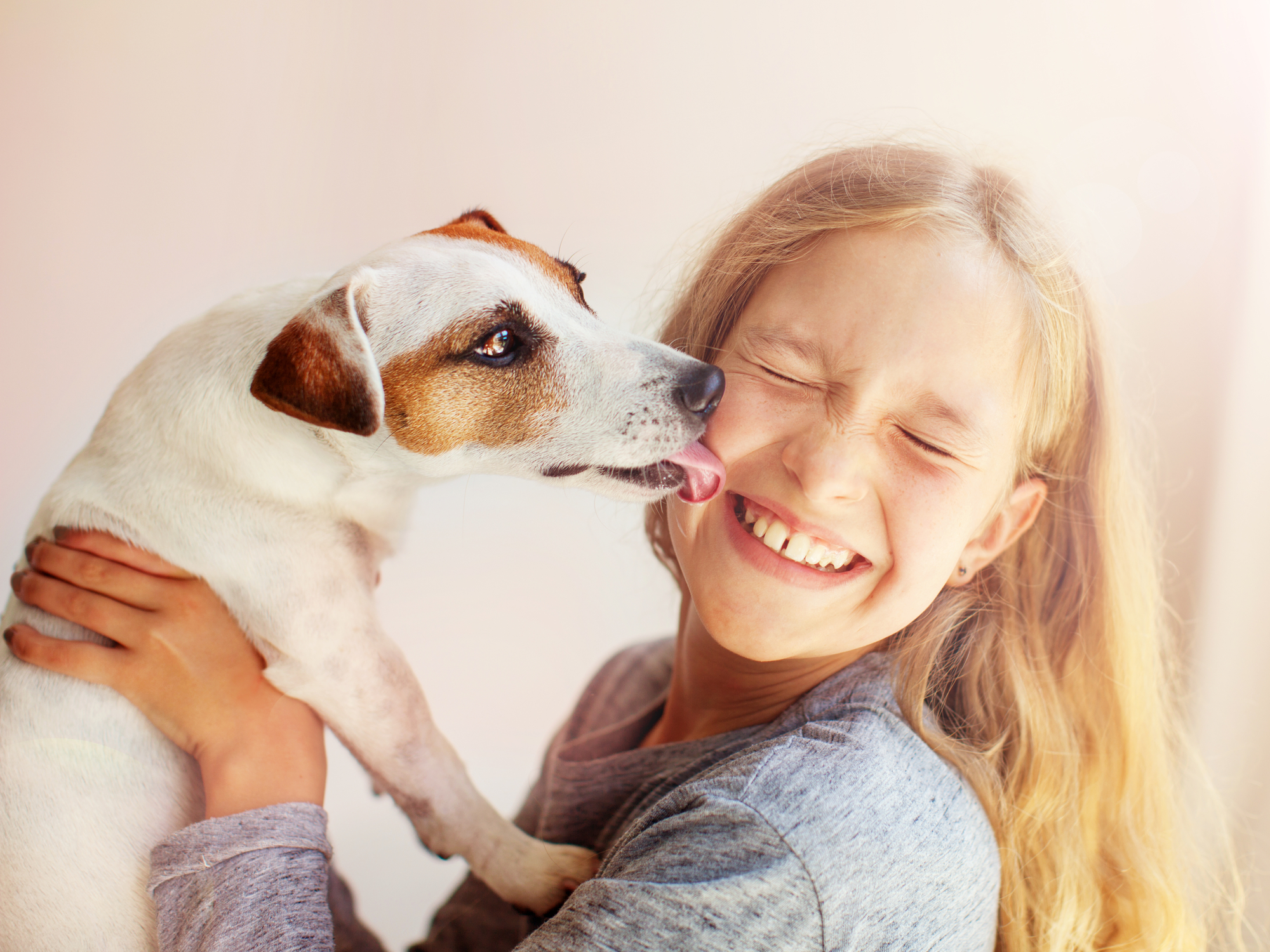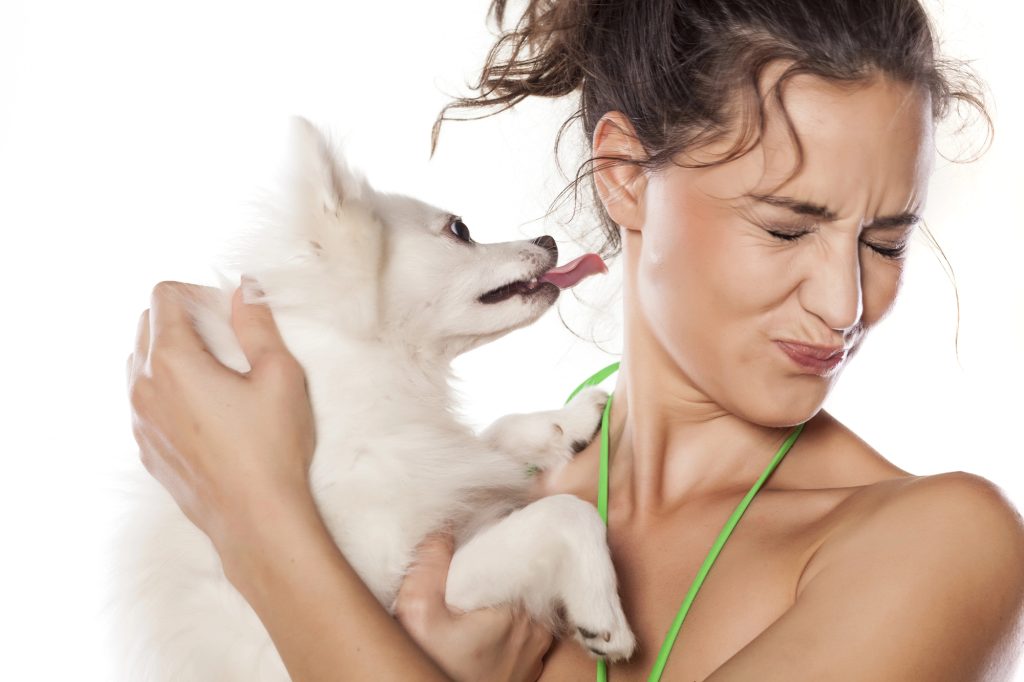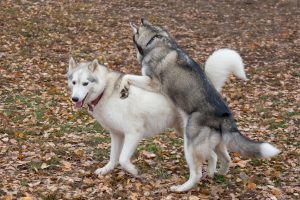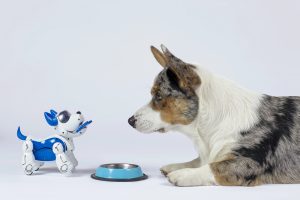
You walk through the door after a long day, and before you can set your keys down, your loyal companion rushes to greet you. Tail wagging furiously, your dog showers you with an enthusiastic barrage of wet, slobbery kisses. It’s a familiar scene for many dog owners, one that brings both a smile to your face and possibly raises a question: Why does my dog lick me so much?
Licking is one of the many ways our dogs communicate with us, and our furry friends use their tongues to tell us myriad messages. Knowing the reasons behind this behavior can help you strengthen the bond you share with your pet. Keep reading to learn about the science and psychology of why your dog has this endearing yet sometimes puzzling habit.
The Science Behind Dog Licking
Licking is an instinctive behavior in dogs, deeply rooted in evolutionary history. The ancestors of modern dogs (wild wolves) would lick pack members to strengthen social bonds, groom each other and communicate their needs. It’s a behavior that’s been passed down through generations, remaining a core aspect of canine interaction.
Licking also triggers the release of endorphins in dogs — just like cuddles and kisses for humans — which can produce a sense of pleasure and relaxation. If you’ve ever noticed your dog looking particularly content during a licking session, that’s why. Furthermore, licking is a form of communication that allows dogs to convey their feelings and intentions. Both a gentle lick on the hand and an enthusiastic face wash are your dog trying to tell you something.
Why Do Dogs Lick You?
Dogs have several reasons for licking their owners:
- Affection. One of the most common reasons dogs lick is to show affection. Licking is a way for dogs to express their love and bond with their owners. It’s a dog version of a hug or a kiss and a sign that it feels secure and connected to you.
- Attention-seeking. Sometimes, dogs lick to grab your attention. If your dog notices that licking gets a response from you — whether it’s a pat on the head or a verbal acknowledgment — it might use this behavior to make sure you notice it, especially when it wants to play or needs something.
- Taste. Believe it or not, your skin can be quite tasty to dogs. Sweat, lotion or the natural oils on your skin can have an appealing flavor. Dogs also have a strong sense of smell, so if you’ve been handling food or other exciting scents, your dog might lick to explore these new tastes.
- Anxiety or stress. Licking can be a self-soothing behavior for dogs, much like humans might bite their nails or fidget when anxious. If your dog is feeling stressed or nervous, it might lick to calm itself down. It might also show other signs of anxiety, such as whining or pacing.
- Habit. If licking has been reinforced over time because you’ve consistently responded positively to it, your dog might have developed it as a habit. Dogs are creatures of habit and will continue behaviors they find rewarding or comforting.
- Medical issues. Sometimes, licking can be a sign of an underlying medical issue. Allergies, skin irritations or pain can cause dogs to lick excessively. If the licking is persistent and focused on a particular area, it’s worth consulting a veterinarian to rule out any health problems.
See also: How to Treat Your Dog’s Ringworm Infection

When Licking Becomes a Problem (Excessive Licking)
Excessive licking is licking that becomes obsessive or interferes with normal activities. A variety of reasons can cause it, including boredom, anxiety or medical issues. Be sure to monitor your dog’s licking behavior to determine if it crosses the threshold into excessive.
Licking excessively can indicate underlying health issues such as allergies, infections or gastrointestinal problems. If your dog is constantly licking itself, furniture or you, it’s a sign that something might be wrong. Consulting a veterinarian can help identify and address the root cause of this behavior.
How to Decode Your Dog’s Licks
To understand your dog’s licks, observe its body language and the context surrounding the licks. Is it licking you when you come home out of sheer excitement or during times of stress? The context can provide clues about what your dog is trying to communicate.
Additionally, consider your dog’s breed and individual personality. Some breeds are more prone to licking than others, and individual dogs may have unique reasons for their behavior. Paying attention to these nuances can help you better understand your furry friend.
Managing Dog Excessive Licking
Managing excessive licking involves understanding the root cause and addressing it appropriately. Here are some strategies to help manage this behavior:
- Rule out medical causes. The first step in managing excessive licking is to rule out any medical issues. A visit to the vet can help identify if there are underlying health problems that need addressing.
- Positive reinforcement. Reinforcing alternative behaviors can be effective in managing licking. Reward your dog for behaviors other than licking and gradually, it will learn that other actions get it the attention and treats it desires.
- Distraction and redirection. Offering alternative activities can help distract your dog from licking. Chew toys, puzzle feeders, and interactive games can keep your dog’s mind occupied and reduce the urge to lick.
- Address anxiety. If anxiety is the cause, creating a calming environment is crucial. This can involve providing a safe space for your dog, using calming aids like pheromone diffusers or working with a professional trainer to address anxiety triggers.
How Can Halo Collar Help an Anxious Dog?
The Halo Collar is a comprehensive tool designed to help pet owners keep their pets safe and content. Let’s look at how Halo Collar’s features and benefits can help you manage an anxious dog:
- Geofencing and safe boundaries. The Halo Collar allows you to set up a wireless dog fence, providing it with a safe, designated area to roam. This can be particularly useful for dogs with anxiety, as it gives them a clear boundary and reduces the stress of unfamiliar environments.
- Activity monitoring. Tracking your dog’s activity levels helps you identify patterns that might indicate stress or anxiety. For instance, increased pacing or restlessness can be signs that your dog is feeling anxious. You can also see if excessive licking starts when the dog hasn’t had enough exercise.
- Training support. The Halo Collar comes with built-in training features that help reinforce positive behaviors.
- Peace of mind. Knowing you can monitor and manage your dog’s behavior even when you’re not home can significantly reduce your anxiety.
- Customizable alerts. You can set up alerts for specific behaviors or activities. If your dog starts exhibiting signs of anxiety, you’ll be notified immediately so you can take action to comfort and reassure it.
See also: How to Help Treat Your Dog’s Separation Anxiety
From Licks to Love: Taking Action for a Happy Pup
Paying attention to your dog’s licking behavior helps you meet its needs and address any potential issues early on. Keep in mind that excessive dog licking can indicate a problem that requires attention. Prioritizing a visit to the vet, investing in a Halo Collar and using positive reinforcement techniques will help you manage this behavior.
For more insights into your dog’s behaviors and how to manage them, visit our blog.






